Kia Cerato 2013 News
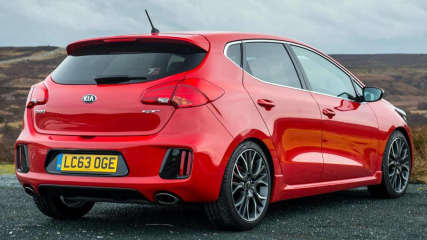
Kia keen for hot hatch return
Read the article
By Richard Blackburn · 03 Mar 2016
Kia is looking to get back into the hot hatch business after pulling the unloved Proceed GT out of the local market last year.

Hyundai i20 v Kia Cerato v Nissan Pulsar | deals
Read the article
By Paul Gover · 26 Sep 2013
Hyundai invented drive-away pricing in Australia and today it's bigger than ever. The Korean company knew it needed something special to get shoppers to sign on the dotted line back in the mid-1990s, and that something was a $990 bottom line across its models with an all-in selling price that removed the fear and uncertainty from buying a new car.Driveaway dealing started as showroom bait for the baby Excel and a new generation of first-time shoppers looking for a bargain at $13,990, in an inspired move by firebrand Hyundai executive Simon Pinnock, and has spread like a virus throughout the Australian motoring landscape since then.Lots of companies now use a driveaway deal to clear their superseded stocks, or re-ignite interest in a fading favourite, or just put some punch into their showroom push. It works, and it usually works well.Right now, Kia is heavily into driveaway dealing as its shifts from 2013 to 2014 models and is even applying the all-in effort - which can save up to $2000 in on-road costs and dealer delivery at a non-luxury brand - to its new-year arrivals. You can get a Rio manual hatch for $15,990 driveaway, compared with a recommended retail sticker at $16,290 before on-roads, and the latest deals even run up to the Carnival people mover and top-end Sorento SUV.Over at Hyundai there is a similar push, not just because of the competition from Kia but because Korea's biggest carmaker intends to be a top-three success in Australia within five years. It knows that driveaway dealing gets people into showrooms and starts its efforts at the very bottom - the i20 is now $13,990 on the road - to try and create loyal buyers who gradually move up through the range.Hyundai and Kia could be accused of racing to the bottom on the price line, but Nissan is doing even sharper deals at $18,990 on-the-road as it looks to turn its all-new Pulsar models into the biggest showroom success of the year. The cars are already locked and loaded, and being rolled onto ships in Japan every month, with the driveaway deals in Australia planned to ensure they go straight to homes without spending any wasted time parked in a dealership.We're also seeing deals with the 'drive away, no more to pay' kicker line being pushed by everyone from Holden and Ford to Subaru and Toyota, even if they are short-lived or wrapped in a different package. But that's not the end of the dollar deals, as cheap finance - down to zero at some brands - is making a bigger impact.Finance deals are partly about winning customers, but also to do it in a way that does not influence the vital resale value on a car. That's because the second hand price is determined by the 'transaction price' - the dollar number as the car is actually retailed, not the showroom sticker - and that can be badly affected by heavy discounting and even driveaway pricing. Price: from $13,990 driveawayEngine: 1.4L four-cylinder, 73.5kW/136NmTransmission: 6-speed manual or 4 speed auto, FWDThirst: 5.3L/100km Price: from $18,990 driveawayEngine: 1.8L four-cylinder, 110kW/178NmTransmission: 6-speed manual/auto, FWDThirst: 6.6L/100km Price: from $18,990 driveawayEngine: 1.8L four-cylinder, 96kW/174NmTransmission: 6-speed manual/CVT auto, FWDThirst: 6.7L/100km
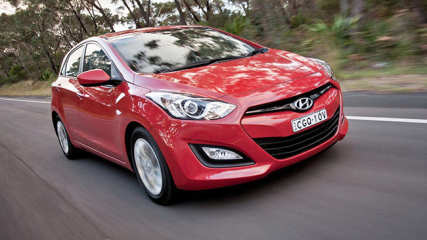
Korea is beating Japanese brands
Read the article
By Paul Gover · 25 Sep 2013
That might sound like a silly answer to a serious question, but it's the best solution for optimum shopping in the back end of 2013. You see, Korea now makes better Japanese cars than the Japanese. And that's a fact.There are some exceptions, and some categories where the Koreans are still getting a foothold, but a Hyundai i30 or a Kia Cerato is a far better choice than a Mitsubishi Lancer, a Kia Sportage makes more sense than a Honda CR-V, and a Hyundai Santa Fe is much better buying than a Toyota Kluger.This Korean tide has been rising for a while, but it's now filled showrooms with quality cars that are backed by industry-leading five-year warranties with capped-price servicing costs. The two Korean juggernauts are also serious about tuning their cars for Australian drivers and roads, which is becoming a serious selling point and also a battlefield for bragging rights between Hyundai and Kia.Even Daewoo, which was absorbed into the Holden empire to provide cut-price cars such as the Barina and Captiva, is now doing a better job as the engineering and design expertise from Fishermans Bend is absorbed deeply into the Korean content on the cars. And don't forget that the Aussie-made Cruze compact, despite its local tweaking and assembly in Adelaide, began its life at the GM Daewoo division in Korea.Without getting into a history lesson, the seismic shift between Japan and Korea comes down to three things. First is the deep-seated rivalry between the two countries, second is the well-lit path to success blazed by Japanese makers including Honda and Toyota, and third is the Global Financial Crisis. How's that?Well, nothing makes a Korean businessman happier than beating a Japanese rival, even though the Japanese were the first Asian companies to achieve success in motoring thanks to cars like the Toyota Corolla, Honda Civic and the classy machines that followed. These days, the Nissan GT-R is a legend and the Toyota LandCruiser is an icon.So the Koreans assimilated the Japanese business model for cheap, reliable and sensible cars - think of the Hyundai Elantra and Kia Rio - and then found a way to build them with similar quality at a lower price. There was a time when the cabins of Korean cars stank - because of the 'release agent' applied to plastic parts - and the assembly was slipshod and downmarket, but not today. They also have aircon with Japanese efficiency, always a pointer to intelligent engineering in Australian weather.But it's the GFC which has made the biggest difference. While the Japanese brands panicked, cutting costs and stretching the lifetimes of their cars, the Koreans accelerated their development plans, brought new models, and invested in their dealerships in Australia.The results are obvious now as many Japanese cars - we're talking about the Honda Civic and Subaru Impreza - have lost their previous edge, while others - think Mitsubishi Pajero and Subaru WRX - are way overdue for a remake.In the meantime, Hyundai is now plotting a move upmarket with its luxury Genesis models and Kia is setting a global standard for quality styling thanks to its recruiting of design genius Peter Schreyer. Best of all, when you're buying, it's the driveaway pricing that's been a Korean signature since Hyundai blazed that trail in the 1990s to get nervous shoppers over the line.This reporter is on Twitter: @paulwardgover
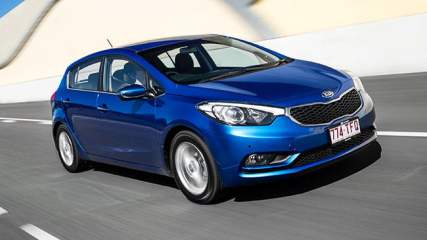
Kia Cerato hatch | new car sales price
Read the article
By Malcolm Flynn · 16 Aug 2013
Kia has introduced a new five-door hatch version of its impressive Cerato small car, joining the existing sedan bodystyle four months after its local arrival.The third-generation Cerato hatch replaces the TD generation hatch that has continued to be available alongside the new YD Cerato sedan, and matches the sedan on pricing and most specifications.Australia is the first market outside Korea to receive the new hatch, and Kia expects the new hatch to make up 70 per cent of Cerato sales. The existing Cerato offerings rank 12th in the highly competitive sub-$40,000 small car segment for sales year to date (until July 31), with 3382 sales, trailing the segment-leading Toyota Corolla and Mazda3 by over 20,000 units over the same period.The wheelbase of the new Cerato hatch matches the sedan’s 50mm longer 2700mm measurement, improving rear seat legroom by a similar margin. Overall length is 210mm less than the sedan due to a shorter rear overhang, which also sees seats-up cargo capacity drop by 97 litres to 385L (VDA), but all models are fitted with a full-size spare wheel.Like the sedan, the new Kia Cerato hatch is available in S, Si, and SLi grades, and kicks off at $19,990 for the S, moving up to $23,990 for the Si, and topping off with the $27,990 SLi.The S comes equipped with air conditioning, cruise control, flex-steer adjustable power steering, front and rear parking sensors, six-speaker audio with Bluetooth audio and telephone. The Si adds a premium steering wheel and gearknob, 4.3 inch colour multimedia touchscreen with reversing camera, extra chrome exterior detailing, auto headlamps, folding door mirrors with puddle lamps, proximity keys, and 16 inch alloy wheels.The top-spec SLi gains leather trim with front seat heaters and power memory driver’s seat adjustment, dual-zone climate control, power sunroof, HID headlamps, LED daytime running lamps and taillamps, auto-dimming rear view mirror, chilled glovebox, and 17 inch alloy wheels.Satellite navigation is only available as a $1000 option on the top-spec SLi models, which also results in the multimedia screen growing to seven inches. The hatch also matches the sedan’s engine lineup, with the S equipped with a 110kW/178Nm 1.8 litre petrol four, and the Si and SLi grades moving up to a 129kW/209Nm 2.0 litre direct injected petrol four.A six-speed manual is standard on all Cerato hatch models, with a six-speed auto available for a further $2000. The Cerato hatch’s combined fuel consumption figures are equal with the sedan, despite weighing 20kg more, which means 6.6l/100km (manual) and 7.1l/100km (auto) for the 1.8 litre S, and 7.4l/100km for the 2.0 Si and SLi variants with either transmission.Like the sedan, the Cerato hatch has achieved a five star ANCAP safety rating, with six-airbags, stability and traction control, and hill-start assist. The Cerato hatch comes with Kia’s five-year unlimited kilometre warranty, capped price servicing plan for the first five services, and one year roadside assistance. The entry S grade (manual) is being offered with $19,990 driveaway pricing from launch, matching the current offer on the sedan S. However, Kia would not confirm the duration of this offer.
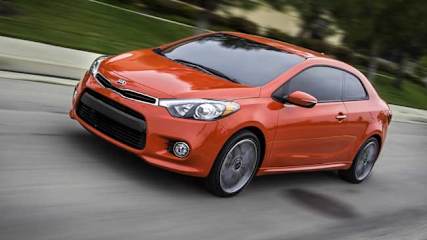
Turbo Kia Cerato Koup debuts
Read the article
By Nelson Ireson · 28 Mar 2013
The Kia Cerato -- called Forte overseas -- Koup lineup just got a whole lot sportier at the 2013 New York Auto Show: the new 201-horsepower, turbocharged Koup SX has made its debut alongside the base Koup EX.With 148kW of power and 264Nm of torque from its 1.6-litre, direct-injected turbo four-cylinder engine -- the same one used in the Hyundai Veloster SR Turbo -- the Cerato Koup SX is the most powerful Koup model ever.With front-wheel drive and a six-speed manual transmission (a six-speed automatic is available), the Koup SX aims to be Kia's sportiest model. The base-model Koup EX comes standard with an automatic transmission for its 2.0-litre, 129kW/209Nm four-cylinder engine -- a rise of 14kW and 15Nm over the current Koup's 2.0-litre."The Forte Koup is arguably the sportiest vehicle in our award-winning lineup, and it has helped raise Kia’s brand awareness significantly among automotive enthusiasts," said Michael Sprague, executive vice president of marketing & communications, Kia Motors America. "Its rakish design, premium amenities and powerful turbocharged engine set it apart from the competition."The Koup SX and EX join the Cerato sedan and hatchback, and despite the performance-directed marketing and turbocharged engine, there's still plenty of Kia value going on as well.As with the Koup EX, standard features include UVO eServices with Rear Camera Display, Bluetooth wireless, SiriusXM satellite radio, LED lighting, and a leather-wrapped steering wheel--but adds 18-inch alloy wheels, dual chrome exhaust tips, and LED tail lights. Optional extras include HID headlights, dual-zone climate control, SmartKey with push-button start, 10-way power driver's seat, and more.The Kia Cerato Koup SX also has its own aesthetic features, with a larger opening in the bumper and grille, black gloss grille inserts, larger front brakes, alloy pedals, and "carbon fiber-style" interior and exterior accents.The new Cerato Koup range is likely to go on sale in the fourth quarter of 2013. Pricing and details of Australian specification will be announced closer to its launch. And while there is no indication yet of whether we'll get the turbocharged Koup SX, Hyundai's success with the Veloster suggests Kia will be looking seriously at the business case.The Car Connection
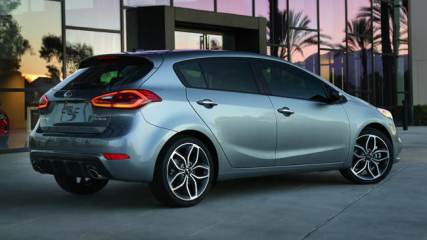
Kia redesigns Cerato
Read the article
By Neil Dowling · 08 Feb 2013
Style is the new weapon in Kia's war to win back buyers from an avalanche of fresh small-car rivals. It starts with the Cerato hatch, a heavily rejigged small car with more performance options that arrives here mid-year with the aim of clawing back some average sales results.
The neat Cerato sedan and hatch currently on the market have been no match for heavy hitters Corolla and Mazda3, let alone its sister Hyundai i30. Even the more expensive Subaru Impreza outsells Cerato.
This time Kia reckons it's got it right. The Cerato, shown this week at the biggest US motor show in Chicago, arrives in Australia as a hatchback in July that follows the April launch of the sedan equivalent. It sits on a 50mm longer wheelbase and is lower and wider than the current hatch.
Boot space is up to 422 litres, bigger than the i30 (378), Golf (350), Corolla (280) and Mazda3 (340) but less than Holden Cruze's 445 litres. Looking more like a mini-Optima at the front - indeed the Cerato sedan is almost a shrunken copy of Kia's biggest Australian-sold sedan - the hatch repeats the crisp styling and signature lines of the company's chief designer Peter Schreyer.
It has all the performance looks to justify Kia's 150kW/264Nm 1.6-litre direct-injection turbo-petrol engine - only 5kW/16Nm off the bigger 2-litre engine of the Golf GTI - but we won't get it. Kia Australia has knocked back this sparkling engine in favour of retaining the current model's 103kW 1.8-litre multi-point injection engine and a perkier 129kW 2-litre direct-injection petrol four.
This upgrades the current 2-litre engine's 115kW/194Nm output. The turbo-petrol engine - the same as fitted to the Hyundai Veloster Turbo - is hoped to be used here late this year as Kia Australia plans to import the Europe-sourced Procee'd GT hatch. Annoyingly, the US market has nabbed the turbo-petrol for the Cerato five-door hatch and displayed it at the Chicago motor show this week.
VALUE
Kia Australia is not talking money. But it's fair to say it will start around the same level - say, $19,990 - because that's where its rivals such as Corolla and Pulsar are starting. At that money, dependent on equipment levels for which Kia are renowned, it'll be a strong buy.
The 2-litre engine is also bigger than the others so there's appeal from a performance base. The elephant in the room is the excellent i30 from parent company Hyundai that shares the Cerato's platform. But there's Kia's industry crunching five-year warranty and capped-price service program with roadside assistance. Strong arguments. But we have to see the car in Australia and with its sticker price to make the final call.
DESIGN
In the flesh it's crisp and distinctive. It's a pleasing car to look at and that'll appeal to buyers who appreciate a head turn. But it's not outrageous and not dated in its lines, so it should age well and that'll hold value. The cabin is pretty and appears workable. The car will keep its three model line-up of S, Si and SLi. Again, the proof is in what it looks like when it lands here.
TECHNOLOGY
The 2-litre engine's direct injection improves performance and lowers fuel consumption. Kia gets unique suspension tuning for Australia - incidentally, Hyundai do likewise but by a different mob - so the Cerato hatch should hang on through the bends. The rear suspension is by torsion beam and though not as sophisticated as the multi-link set up of Holden and Opel, is economical and allows for a bigger boot area.
SAFETY
No news but it's expected to be a five-star car with six airbags. It's the standard safety gear that gets fitted to the Australian cars which is unknown. A rear camera should be the minimum with lane-change monitor and even low-speed auto braking being desirable. In this sector though, it's all about price.
VERDICT
A very appealing package that offers good space in a relatively small car. Nice to see some power upgrades in the 2-litre which should make it a fun drive. The car isn't on the road - or even a carpark - yet.
Kia Cerato hatch
Price: est from $19,990
Warranty: 5 years/unlimited km, roadside assist
Resale: 53%
Service Interval: 12mths/15,000km, capped price
Safety: 6 airbags, ABS, ESC, EBD, TC
Crash rating: 5-star
Engine: 1.8 and 2-litre 4-cyl turbo-diesel, 103kW and 129kW
Transmission: 6 spd manual or auto; front drive
Thirst: est. 7.3L/100km; 192g/km CO2
Dimensions: 4.3m (L), 1.8m (W), 1.5m (H)
Weight: 1385kg
Spare: Full size
RIVALS
Toyota Corolla
Price: from $19,990
Engine: 1.8-litre, 4-cyl petrol, 103kW/173Nm
Transmission: CVT; front drive
Thirst: 6.6L/100km; CO2 152g/km
Toyota Corolla - see other Corolla verdicts
Mazda 3
Price: from $20,330
Engine: 2-litre, 4-cyl petrol, 108kW/182Nm
Transmission: 5-spd auto; front drive
Thirst: 8.2L/100km; CO2 216g/km
Mazda 3 - see other Mazda 3 verdicts
Holden Cruze
Price: from $21,490
Engine: 1.8-litre, 4-cyl petrol, 104kW/176Nm
Transmission: 6-speed auto; front drive
Thirst: 7.5L/100km; CO2 179g/km
Holden Cruze - see other Cruze verdicts
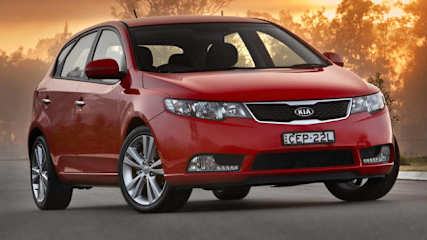
Kia Cerato gets 2013 update
Read the article
By Paul Gover · 04 Dec 2012
The upcoming Cerato is revealed in a shiny new suit at the Los Angeles Auto Show with the promise of a four-door sedan, five-door coupe and the two-door Koup to be rolled out through next year.
The Cerato triplets pick up the latest Korean mechanical package from the Hyundai i30 but, crucially, will benefit from the Australianisation which has given Kia's cars a driving edge over the equivalent Hyundai models sold in Australia.
The car was designed in Los Angeles and is badged as the Forte for America, but only those badges - and the final tweaking - will change for Australia "It's called the Forte in the US, but it is our Cerato," confirms Kevin Hepworth of Kia Motors Australia in LA.
"The sedan will be in April, followed but the five-door - probably in July - and the two-door Koup very late in the year. "The Cerato is our volume car. The sedan is one of our main fleet cars and the hatch is the top selling model. Even in runout at the moment the old car is selling strongly."
He cannot talk about Cerato pricing, which currently starts just a little under $20,000 for both the sedan and hatch, but is not forecasting any dramatic change for customers. "We've got no idea on price at this stage. But it will be typical Kia, so if there is an increase at all it won't be a big increase," Hepworth says.
The emphasis in LA is on the car's design, including a significant upgrade of cabin quality and extra standard equipment at all levels. But the third-generation car is also longer, lower and wider than the one it will replace.
The styling is bold and, in some ways, the Cerato looks like a shrunken Optima. Inside, it looks good and the American models are promised with everything from Bluetooth streaming and fan-forced seat cooling to satellite radio and an LCD dashboard display.
None of the equipment, or a mechanical package with two engines and six-speed manuals and autos for America, is confirmed yet for Australia. "It's largely about the design at the moment. And timing is important, because last time we didn't have a hatch until 18 months from the end of the model," says Hepworth.
"At the moment the engines look like a carryover 2-litre from the existing model. But the ride-and-handling team have got to the car quite early and done significant work. "We have the timing, we have a natural progression of models, and it's a style-driven vehicle."
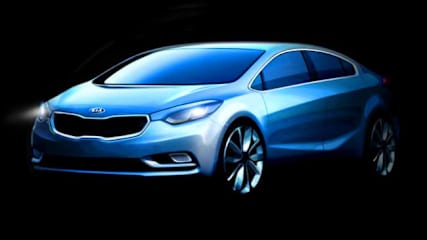
2013 Kia Cerato images teased
Read the article
By Karla Pincott · 23 Jul 2012
The car will be unveiled at the Los Angeles motor show in November, but in the meantime Kia has released these teaser images showing a strong coupe look for the four-door small sedan.
A more upswept ‘tiger face’ grille, sharply angled headlights and accentuated character lines pull the eyes along the rising beltline to the fast sweep over the tail.
Like the latest Rio, it heralds that Kia is not resting on the design laurels of the past couple of years – and that we can expect to see increasingly fresher styling roll out under the watch of design chief Peter Schreyer.
We will see the new Cerato sedan here in the first half of 2013, with the five-door hatch and Koup following later that year. There’s also the whiff of a turbo option, with Hyundai tipped to be planning a turbo i30 – a car that shares some underpinnings with the stablemate Cerato.
There's no news on prices yet, but while Kia has been showing for some time they have moved away from the bargain basement, you can still expect the Korean carmaker to focus on ensuring the line-up is good value for money. So there is unlikely to be a huge change from the current model pricing, which starts just under $20,000 for the base model sedans and hatches and tops out at just under $30,000 for the top spec Koup.
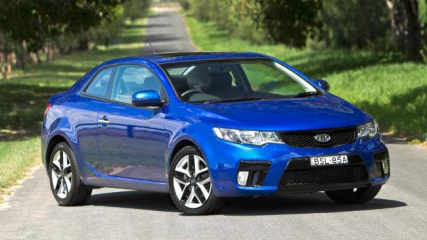
Kia Koup getting set for turbo
Read the article
By Neil Dowling · 22 May 2012
But that won't happen until at least next year as Kia rolls out its new Cerato hatch and sedan and, finally, the two-door Koup. "We're pushing hard for a turbo car but we have to be patient," Kia Australia spokesman Kevin Hepworth says.
The next model Koup is expected to get a direct petrol-injected 1.6-litre engine with a turbocharger. Kia's global powertrain engineer, Joachim Hahn, indicated at this year's Geneva motor show in March that the first turbo would be in a C-Class car - which is the Cerato - and that it would be announced within 12 months.
"We already make a turbocharged direct-injection engine - the TGDI - and we will bring out a Kia within the next 12 months which is a European GDI turbocharged engine," Hahn says. Kia - an associate company of Hyundai - makes a turbocharged version of the Optima for the US market and a C'eed turbo for Europe.
The US also gets a turbo-petrol Sportage. The 150kW/264Nm 1.6-litre turbo-GDI engine - which features a twin-scroll turbocharger - is also in the Hyundai Veloster Turbo which is due for Australian launch in December. Hyundai claims its Veloster Turbo is able to deliver 8.7 L/100km city and 6.2 L/100km highway for manual transmission models. It is also available with a six-speed torque-converter automatic.
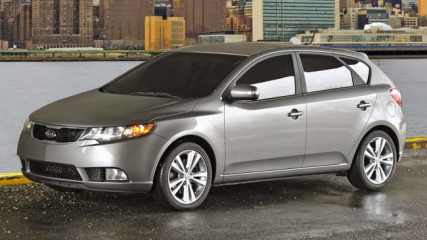
Kia's new cars on the way
Read the article
By Stuart Martin · 12 Aug 2010
While the company has launched the Sportage with a locally-tuned suspension and played with a Koup to make it handle, the Korean brand has critical vehicles coming. Kia Australia national marketing manager Steve Watt says the next-generation Rio - due in the latter half of next year - is a critical car for the brand."I've seen the clay of Rio, it's a game-changer, the packaging is more for a small family because it is so clever, that's second half of 2011," he says. The line-up is far from set, but Watt says the range will need to retain the brand's sharp-pricing as well as cover a broader range of body options."We're known for sharp prices - entry level we need a presence, hopefully we'll have access to different body shapes, sedan and wagon and hopefully a three-door but that's not confirmed, the greater coverage we have the better we'll do," he says. The company will add the Cerato five-door to its line-up following a Sydney motor show debut in October.The medium sedan - still known as TF for now but likely to use the Optima nameplate - will be unveiled at the Australian Open in Melbourne early next year, with even more suspension and steering work done by the Australian tuning team than the Sportage."The TF we have started chassis dynamics testing on that car, that determines when it goes on sale - when the work is finished. It costs the same to put a poor as a good suspension system in the car, the trick is to get a good suspension." he says.Watt says the brand is still considering tactics like a seven-year warranty and says it has to expand its catchment of customers and agrees that the company's line-up need to be seen as "more than A to B" transport."A to B suggests being disconnected with the car, our designs now are for more engaging, you notice the car now - my view is the drive needs to match the style of the car. We need to talk to a new market, we need to talk to people who wouldn't have considered us before," he says.




